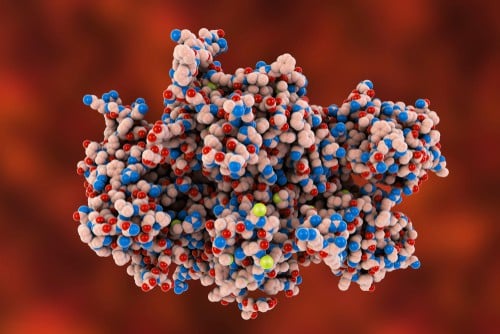
A Little Bit of History
In 1837-1901, Queen Victoria of England ruled and was believed to have passed on the traits of hemophilia B to three of her nine children. Her daughters then passed it on to their children, one of whom married Tsar Nicholas of Russia, resulting in their son Alexei having hemophilia – this family’s involvement with Rasputin during the Bolshevik Revolution has been documented in writing and film. This is how hemophilia also became known as the “royal disorder” until it seemed to disappear from the royal families in 1901.
Abnormal bleeding was first identified hundreds of years ago, and in 1803, an article was published by John Conrad Otto, identifying a hemorrhagic bleeding disorder that mainly affected men in certain families. In 1828, Freidrich Hopff and Dr. Schonlein created the term “haemorrhaphilia” for this same condition, which became known as hemophilia. By 1947, Dr. Alfredo Pavlosky identified two types of hemophilia, called A and B.
Hemophilia, a rare genetic disorder, occurs when blood does not have enough blood-clotting proteins so it can’t clot normally. This means someone with hemophilia will bleed a lot longer after sustaining an injury since the blood doesn’t clot to stop the bleeding. The biggest concern is the risk of internal bleeding that can damage tissues and organs, becoming a threat to life.
Abnormal bleeding was first identified hundreds of years ago, and in 1803, an article was published by John Conrad Otto, identifying a hemorrhagic bleeding disorder that mainly affected men in certain families. In 1828, Freidrich Hopff and Dr. Schonlein created the term “haemorrhaphilia” for this same condition, which became known as hemophilia. By 1947, Dr. Alfredo Pavlosky identified two types of hemophilia, called A and B.
Hemophilia, a rare genetic disorder, occurs when blood does not have enough blood-clotting proteins so it can’t clot normally. This means someone with hemophilia will bleed a lot longer after sustaining an injury since the blood doesn’t clot to stop the bleeding. The biggest concern is the risk of internal bleeding that can damage tissues and organs, becoming a threat to life.
Who can get hemophilia?
People who have hemophilia have low levels of clotting factor VIII or clotting factor IX – the severity of the disorder is determined by how much clotting factor is in the blood. The lower the amount means the more severe the disorder.
More males have hemophilia; however, some women can develop it too. Males who inherit an X chromosome with a mutation in the gene responsible for developing clotting factor proteins can get hemophilia, and females who have hemophilia are a result of one or both X chromosomes having a mutation in one of the factors. A female with one affected X chromosome is considered a “carrier” and may pass it onto her children, without having any symptoms herself.
Currently, there are about 20,000 men in the US living with hemophilia. Around the world, it’s estimated that almost half a million people have hemophilia, but 75% are unable to receive adequate treatment.
More males have hemophilia; however, some women can develop it too. Males who inherit an X chromosome with a mutation in the gene responsible for developing clotting factor proteins can get hemophilia, and females who have hemophilia are a result of one or both X chromosomes having a mutation in one of the factors. A female with one affected X chromosome is considered a “carrier” and may pass it onto her children, without having any symptoms herself.
Currently, there are about 20,000 men in the US living with hemophilia. Around the world, it’s estimated that almost half a million people have hemophilia, but 75% are unable to receive adequate treatment.
Types of Hemophilia
There are two types of hemophilia, based on the clotting factors in the blood that were not produced properly due to the gene mutation. Problems with factor VIII causes hemophilia A, and factor IX issues cause hemophilia B.
These clotting factors are both proteins in the blood that assist with clotting, and having hemophilia means there are either very low amounts of the clotting factor in the blood, or there are abnormal versions present that don’t function normally.
Hemophilia can be mild or moderate based on the level of clotting factor – the most common form is hemophilia A, occurring in 1 in 5,000 live births. Hemophilia B occurs in about 1 in 12,000 live births.
Acquired hemophilia is another form of the disorder, which is not caused by gene mutations. Instead, it begins in adulthood and is a result of autoantibodies (specialized proteins) that are formed by the body and attack clotting factor VIII, resulting in abnormal bleeding.
These clotting factors are both proteins in the blood that assist with clotting, and having hemophilia means there are either very low amounts of the clotting factor in the blood, or there are abnormal versions present that don’t function normally.
Hemophilia can be mild or moderate based on the level of clotting factor – the most common form is hemophilia A, occurring in 1 in 5,000 live births. Hemophilia B occurs in about 1 in 12,000 live births.
Acquired hemophilia is another form of the disorder, which is not caused by gene mutations. Instead, it begins in adulthood and is a result of autoantibodies (specialized proteins) that are formed by the body and attack clotting factor VIII, resulting in abnormal bleeding.
Signs and Symptoms
Signs and symptoms vary depending on the level of clotting factors present in the blood. Mild symptoms are a result of trauma (such as surgery or injury) causing bleeding. A severe case results in spontaneous bleeding.
Someone with hemophilia may experience unexplained and excessive bleeding from cuts, injuries, or surgery (including dental work). They may see multiple large bruises on their skin (bleeding under the skin), bleeding after shots/vaccinations, blood in urine or in stool, or sudden nosebleeds that don’t seem to have a cause. Joints can start feeling swollen, painful, or tight, meaning there is internal bleeding in the joints.
Hemophilia is especially dangerous for bleeding in the brain – a bump on the head could result in bleeding in the brain for those with severe hemophilia, and it’s a serious complication of the disorder. Someone with bleeding in the brain may experience an ongoing painful headache, vomiting, sleepiness, double vision, sudden weakness, or seizures.
Someone with hemophilia may experience unexplained and excessive bleeding from cuts, injuries, or surgery (including dental work). They may see multiple large bruises on their skin (bleeding under the skin), bleeding after shots/vaccinations, blood in urine or in stool, or sudden nosebleeds that don’t seem to have a cause. Joints can start feeling swollen, painful, or tight, meaning there is internal bleeding in the joints.
Hemophilia is especially dangerous for bleeding in the brain – a bump on the head could result in bleeding in the brain for those with severe hemophilia, and it’s a serious complication of the disorder. Someone with bleeding in the brain may experience an ongoing painful headache, vomiting, sleepiness, double vision, sudden weakness, or seizures.
Diagnosis
Parents who know hemophilia is in their family will usually want their baby boy tested to see if he’s a carrier of the disorder. Genetic testing can also be performed before pregnancy to see if the parents are carriers of the hemophilia. However, 30% of hemophilia diagnoses are in people who don’t have any family history of it.
A blood test can be performed on children and adults to see if there is a clotting-factor deficiency. If it’s a severe case, it’s typically diagnosed within a year of birth due to the symptoms; while mild forms may not be diagnosed until adulthood due to the mild symptoms, or not finding out until having a surgery that results in excessive bleeding.
A blood test can be performed on children and adults to see if there is a clotting-factor deficiency. If it’s a severe case, it’s typically diagnosed within a year of birth due to the symptoms; while mild forms may not be diagnosed until adulthood due to the mild symptoms, or not finding out until having a surgery that results in excessive bleeding.
Treatment
There is no cure for hemophilia, only treatments to help the blood clot more efficiently. The most common treatment for severe forms of hemophilia is receiving a replacement for the clotting factor that isn’t functioning properly through a tube in the vein. This can help ease a current bleed, or administered regularly to help prevent excess bleeding. Some replacement clotting factor is made from donated blood, and other products are made in a laboratory.
Medications are also available as treatment – there are clot-preserving medications that work to keep clots from breaking down after forming, or a hormone can be taken (desmopressin) that helps stimulate the production of more clotting factor as an injection or nasal spray.
When there’s an open bleeding injury, fibrin sealants can be applied right to the injury site to increase clotting and healing. Ice packs and bandages with pressure are also used for minor cuts.
When there is an issue of internal bleeding, such as with joints, physical therapy is prescribed to help ease symptoms. When there has been severe damage from internal bleeding, surgery may help with recovery. People with hemophilia are also encouraged to exercise regularly to build muscles and protect joints.
Anyone who has hemophilia, especially children, are highly encouraged to be careful in every day life, and wear a helmet and pads whenever they’re involved in physical activities that could result in an injury (but avoiding any contact sports). They should also ensure their homes don’t contain furniture with particularly sharp corners.
Medications are also available as treatment – there are clot-preserving medications that work to keep clots from breaking down after forming, or a hormone can be taken (desmopressin) that helps stimulate the production of more clotting factor as an injection or nasal spray.
When there’s an open bleeding injury, fibrin sealants can be applied right to the injury site to increase clotting and healing. Ice packs and bandages with pressure are also used for minor cuts.
When there is an issue of internal bleeding, such as with joints, physical therapy is prescribed to help ease symptoms. When there has been severe damage from internal bleeding, surgery may help with recovery. People with hemophilia are also encouraged to exercise regularly to build muscles and protect joints.
Anyone who has hemophilia, especially children, are highly encouraged to be careful in every day life, and wear a helmet and pads whenever they’re involved in physical activities that could result in an injury (but avoiding any contact sports). They should also ensure their homes don’t contain furniture with particularly sharp corners.
Sources and More Information
Centers for Disease Control and Prevention, “Hemophilia” https://www.cdc.gov/ncbddd/hemophilia/facts.html
Mayo Clinic, “Hemophilia” https://www.mayoclinic.org/diseases-conditions/hemophilia/symptoms-causes/syc-20373327
National Hemophilia Foundation, “History of Bleeding Disorders” https://www.hemophilia.org/Bleeding-Disorders/History-of-Bleeding-Disorders
National Institute of Health – Genetics Home Reference, “Hemophilia” https://ghr.nlm.nih.gov/condition/hemophilia#genes
Mayo Clinic, “Hemophilia” https://www.mayoclinic.org/diseases-conditions/hemophilia/symptoms-causes/syc-20373327
National Hemophilia Foundation, “History of Bleeding Disorders” https://www.hemophilia.org/Bleeding-Disorders/History-of-Bleeding-Disorders
- “Fast Facts” https://www.hemophilia.org/About-Us/Fast-Facts
- “Hemophilia A” https://www.hemophilia.org/Bleeding-Disorders/Types-of-Bleeding-Disorders/Hemophilia-A
National Institute of Health – Genetics Home Reference, “Hemophilia” https://ghr.nlm.nih.gov/condition/hemophilia#genes


